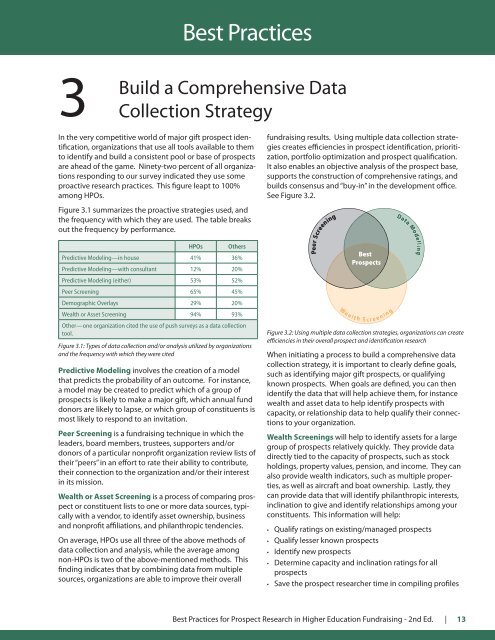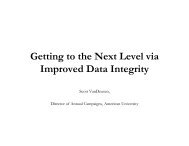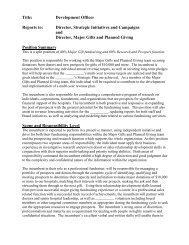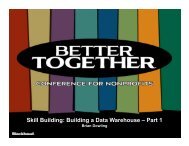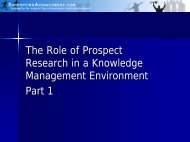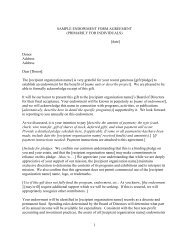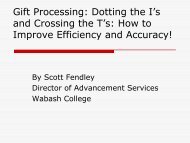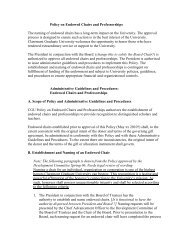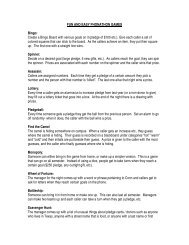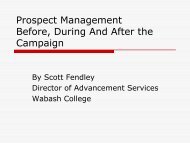WealthEngine Best Practices in Higher Education for Prospect ...
WealthEngine Best Practices in Higher Education for Prospect ...
WealthEngine Best Practices in Higher Education for Prospect ...
Create successful ePaper yourself
Turn your PDF publications into a flip-book with our unique Google optimized e-Paper software.
<strong>Best</strong> <strong>Best</strong> <strong>Practices</strong> <strong>Practices</strong> <strong>in</strong> Action<br />
3<br />
Build a Comprehensive Data<br />
Collection Strategy<br />
In the very competitive world of major gift prospect identification,<br />
organizations that use all tools available to them<br />
to identify and build a consistent pool or base of prospects<br />
are ahead of the game. N<strong>in</strong>ety-two percent of all organizations<br />
respond<strong>in</strong>g to our survey <strong>in</strong>dicated they use some<br />
proactive research practices. This figure leapt to 100%<br />
among HPOs.<br />
Figure 3.1 summarizes the proactive strategies used, and<br />
the frequency with which they are used. The table breaks<br />
out the frequency by per<strong>for</strong>mance.<br />
HPOs<br />
Others<br />
Predictive Model<strong>in</strong>g—<strong>in</strong> house 41% 36%<br />
Predictive Model<strong>in</strong>g—with consultant 12% 20%<br />
Predictive Model<strong>in</strong>g (either) 53% 52%<br />
Peer Screen<strong>in</strong>g 65% 45%<br />
Demographic Overlays 29% 20%<br />
Wealth or Asset Screen<strong>in</strong>g 94% 93%<br />
Other—one organization cited the use of push surveys as a data collection<br />
tool.<br />
Figure 3.1: Types of data collection and/or analysis utilized by organizations<br />
and the frequency with which they were cited<br />
Predictive Model<strong>in</strong>g <strong>in</strong>volves the creation of a model<br />
that predicts the probability of an outcome. For <strong>in</strong>stance,<br />
a model may be created to predict which of a group of<br />
prospects is likely to make a major gift, which annual fund<br />
donors are likely to lapse, or which group of constituents is<br />
most likely to respond to an <strong>in</strong>vitation.<br />
Peer Screen<strong>in</strong>g is a fundrais<strong>in</strong>g technique <strong>in</strong> which the<br />
leaders, board members, trustees, supporters and/or<br />
donors of a particular nonprofit organization review lists of<br />
their “peers” <strong>in</strong> an ef<strong>for</strong>t to rate their ability to contribute,<br />
their connection to the organization and/or their <strong>in</strong>terest<br />
<strong>in</strong> its mission.<br />
Wealth or Asset Screen<strong>in</strong>g is a process of compar<strong>in</strong>g prospect<br />
or constituent lists to one or more data sources, typically<br />
with a vendor, to identify asset ownership, bus<strong>in</strong>ess<br />
and nonprofit affiliations, and philanthropic tendencies.<br />
On average, HPOs use all three of the above methods of<br />
data collection and analysis, while the average among<br />
non-HPOs is two of the above-mentioned methods. This<br />
f<strong>in</strong>d<strong>in</strong>g <strong>in</strong>dicates that by comb<strong>in</strong><strong>in</strong>g data from multiple<br />
sources, organizations are able to improve their overall<br />
fundrais<strong>in</strong>g results. Us<strong>in</strong>g multiple data collection strategies<br />
creates efficiencies <strong>in</strong> prospect identification, prioritization,<br />
portfolio optimization and prospect qualification.<br />
It also enables an objective analysis of the prospect base,<br />
supports the construction of comprehensive rat<strong>in</strong>gs, and<br />
builds consensus and “buy-<strong>in</strong>” <strong>in</strong> the development office.<br />
See Figure 3.2.<br />
Peer Screen<strong>in</strong>g<br />
Wealth<br />
<strong>Best</strong><br />
<strong>Prospect</strong>s<br />
Screen<strong>in</strong>g<br />
Data Modell<strong>in</strong>g<br />
Figure 3.2: Us<strong>in</strong>g multiple data collection strategies, organizations can create<br />
efficiencies <strong>in</strong> their overall prospect and identification research<br />
When <strong>in</strong>itiat<strong>in</strong>g a process to build a comprehensive data<br />
collection strategy, it is important to clearly def<strong>in</strong>e goals,<br />
such as identify<strong>in</strong>g major gift prospects, or qualify<strong>in</strong>g<br />
known prospects. When goals are def<strong>in</strong>ed, you can then<br />
identify the data that will help achieve them, <strong>for</strong> <strong>in</strong>stance<br />
wealth and asset data to help identify prospects with<br />
capacity, or relationship data to help qualify their connections<br />
to your organization.<br />
Wealth Screen<strong>in</strong>gs will help to identify assets <strong>for</strong> a large<br />
group of prospects relatively quickly. They provide data<br />
directly tied to the capacity of prospects, such as stock<br />
hold<strong>in</strong>gs, property values, pension, and <strong>in</strong>come. They can<br />
also provide wealth <strong>in</strong>dicators, such as multiple properties,<br />
as well as aircraft and boat ownership. Lastly, they<br />
can provide data that will identify philanthropic <strong>in</strong>terests,<br />
<strong>in</strong>cl<strong>in</strong>ation to give and identify relationships among your<br />
constituents. This <strong>in</strong><strong>for</strong>mation will help:<br />
Qualify rat<strong>in</strong>gs on exist<strong>in</strong>g/managed prospects<br />
Qualify lesser known prospects<br />
Identify new prospects<br />
Determ<strong>in</strong>e capacity and <strong>in</strong>cl<strong>in</strong>ation rat<strong>in</strong>gs <strong>for</strong> all<br />
prospects<br />
Save the prospect researcher time <strong>in</strong> compil<strong>in</strong>g profiles<br />
<strong>Best</strong> <strong>Practices</strong> <strong>for</strong> <strong>Prospect</strong> Research <strong>in</strong> <strong>Higher</strong> <strong>Education</strong> Fundrais<strong>in</strong>g - 2nd Ed. | 13


